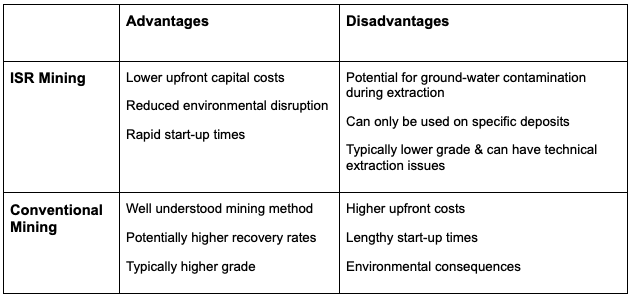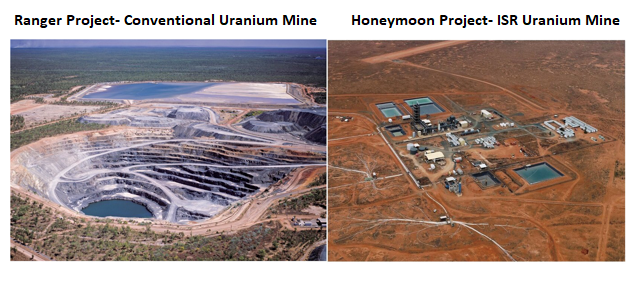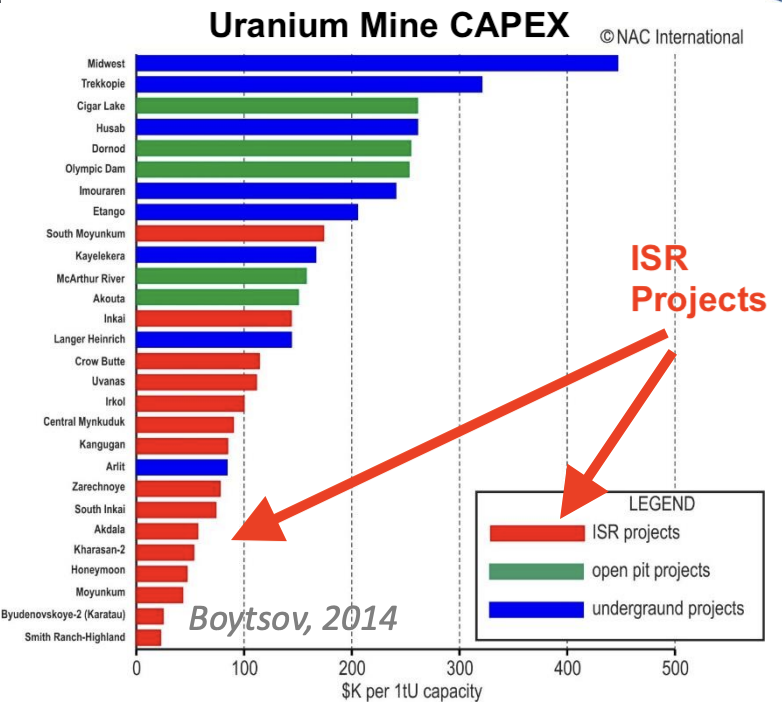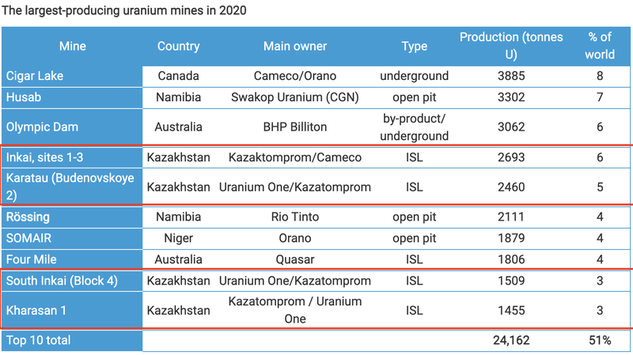Mining for Uranium: ISR vs Conventional Mining
Published 13-JUL-2023 14:12 P.M.
|
2 minute read
There are two primary ways in which uranium is mined:
- Conventional hard rock deposits - projects mined using conventional mining techniques - think a giant open pit/underground mine.
- ISR deposits - ISR stands for “In Situ Recoverable” or “In Situ Leach” (ISL) - these are more comparable to oil and gas projects whereby wells are drilled into the ground and a liquid solution (containing uranium) is pumped back up to surface.
There are some key differences between the two mining methods that we will look at in this article, but here is a brief overview:

In this article we focus on ISR deposits, investigating what they are and how they work.
What is ISR uranium mining?
ISR extraction involves pumping an acid solution into a uranium orebody underground.
This solution then dissolves the uranium before the solution is pumped back up to the surface, where the uranium is separated from the solution.
This is how it looks in a diagram:

(Source)
Benefits of ISR uranium mining
The typical benefits of ISR uranium projects are:
- Low cost due to favourable CAPEX and OPEX; and
- Lower impact on the environment compared to conventional hard rock mining
Below is a visual representation of the differences (left is a conventional hard rock uranium mine and on the right an ISR mine).

From these visual differences between the two types of mining you can start to understand where these cost advantages come from.
Both methods extract the valuable uranium, but with conventional mining there is an extra cost in removing all of the waste rock compared to pumping the uranium from underground.
Here is a table that describes the key differences between the two types of uranium mines:

Below is a chart showing the CAPEX differences between ISR and conventional mines:

(Source)
It's also no surprise to us that the world’s biggest producer of uranium (Kazakhstan) is also operating mostly ISR mines.

(Source)
Kazakhstan accounts for ~41% of Global Uranium supply and is the lowest-cost producer in the world.
In the past the US was a major producer of uranium and was also producing most of its uranium from ISR amenable projects.
How to evaluate ISR uranium investments
Both ISR and conventional uranium mines have their independent pros and cons.
The characteristics of a uranium deposit, such as its depth, ore softness and grade will usually determine the best method of uranium mining - ISR or conventional.
As an investor you’ll need to evaluate if the project is economic based on the overall merits, and not just the type of uranium deposit on hand.
General Information Only
S3 Consortium Pty Ltd (S3, ‘we’, ‘us’, ‘our’) (CAR No. 433913) is a corporate authorised representative of LeMessurier Securities Pty Ltd (AFSL No. 296877). The information contained in this article is general information and is for informational purposes only. Any advice is general advice only. Any advice contained in this article does not constitute personal advice and S3 has not taken into consideration your personal objectives, financial situation or needs. Please seek your own independent professional advice before making any financial investment decision. Those persons acting upon information contained in this article do so entirely at their own risk.
Conflicts of Interest Notice
S3 and its associated entities may hold investments in companies featured in its articles, including through being paid in the securities of the companies we provide commentary on. We disclose the securities held in relation to a particular company that we provide commentary on. Refer to our Disclosure Policy for information on our self-imposed trading blackouts, hold conditions and de-risking (sell conditions) which seek to mitigate against any potential conflicts of interest.
Publication Notice and Disclaimer
The information contained in this article is current as at the publication date. At the time of publishing, the information contained in this article is based on sources which are available in the public domain that we consider to be reliable, and our own analysis of those sources. The views of the author may not reflect the views of the AFSL holder. Any decision by you to purchase securities in the companies featured in this article should be done so after you have sought your own independent professional advice regarding this information and made your own inquiries as to the validity of any information in this article.
Any forward-looking statements contained in this article are not guarantees or predictions of future performance, and involve known and unknown risks, uncertainties and other factors, many of which are beyond our control, and which may cause actual results or performance of companies featured to differ materially from those expressed in the statements contained in this article. S3 cannot and does not give any assurance that the results or performance expressed or implied by any forward-looking statements contained in this article will actually occur and readers are cautioned not to put undue reliance on forward-looking statements.
This article may include references to our past investing performance. Past performance is not a reliable indicator of our future investing performance.



